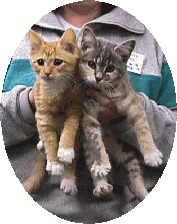
|
|

|
|
I know, a lot of
people only see the cute faces of the animals at the Shelter, and it's
a tragedy if even one animal deserving of a home has to die. But,
I admit, I'm a numbers person. And it's the numbers that tell me
a lot about where the problems are and what can be done to fix them.
I first started
volunteering at my local shelter (Hawthorne, CA) in 1987, and they made
their statistics public monthly. Lots of people know about Kitten
Season. Because cats tend to breed seasonally, even in mild
climates like ours, shelters everywhere are flooded with kittens during
the summer months, while there are few around at Christmas, when so
many people are looking to give them as presents. We used to joke
that, if only we could put them in suspended animation for a few a
months . . .
The numbers at
the Hawthorne shelter were staggering. Just about every month, 100
cats were adopted from the shelter. In December, only about 100
came in, so very few animals had to be euthanized. But in July, 900
cats came in. That tells you a lot about how many healthy,
adorable kittens have to be euthanized just because too few cats are
spayed or neuter.
Fast forward to December
2000,
after I'd been in Oregon a few years and getting involved in some Coos County animal rescue work,
I started asking about our shelter statistics. I went to the shelter
and asked, and found out that, while they had the dog records on
computer, they had only guestimates on cats. Mostly, I was
wondering about the Kitten Season numbers. I thought if I could
tell people about those same kind of numbers here, at our very own
shelter, that it would convince people to have their pets neutered.
I asked if I could
look through the records to determine the stats, and was told, "They're
public records. I couldn't stop you if I wanted."
It was not
easy. I must have spent about 40 hours over the course of the
next few months trying to pull out the numbers. And going home
and crying. Even not seeing the faces, I was still pouring over
all those records with such sad excuses for why people brought in their
animals to have them killed.
The euthanasia
records were carefully kept. Because that involves controlled
substances, they legally have to be. I know the figures I have for
those are correct. But finding out how many cats came in or were
adopted out was far more difficult and I don't know how accurate those
final numbers were.
Let me take a moment
here to talk about blame. The shelter staff is wonderful and
they're doing their best. They don't kill animals because they
think it's fun. It's the job that we, the voters, pay them to do.
The Coos County
shelter is understaffed and underfunded. It's run by the
Sheriff's Dept and they have a lot of other things to do. Their
training and their priorities are not matched to running an animal
shelter. The Coos County Commissioners set the shelter budget,
but they act in accordance with the wishes of the voters.
And even a well-funded, fully staffed shelter wouldn't be enough. The problem is too
many animals and not enough homes. It's a problem for every
animal shelter in the country. It's less in some areas,
especially those that are more affluent and urban, where there have
been spay/neuter programs in place for many years. But it is not the fault of the shelter.
I must also point
out that there's been a change in shelter staff since I gathered these
stats, and there many other changes.
For 2000, there's information on the web for most of the shelters in Oregon at: http://www.co.multnomah.or.us/dbcs/pets/stats.shtml
I asked them where
they got the stats for our shelter, when I'd had such a hard time getting them.
Our shelter had given them an estimate by doing a count for one month
(May) and multiplying by 12. You may notice the numbers for dogs
are close to mine, but, because of Kitten Season, quite
different for cats.
I did some comparisons with other shelters. While our shelter's euthanasia rate is much higher than
Oregon's average or the national average, it's actually pretty typical
of rural Oregon's shelters.
But some people do
blame our shelter and shelter staff for these numbers, and the
Sheriff's Dept now refuses to release any statistics or to allow anyone to
look at the records. I may say I even approached the Sheriff's office with
a paper I offered to sign stating I would not release my findings to
the public without his permission, but I was still denied access.
Given what I was told initially, and what I've read on the net about
the Oregon Public Records Act I don't think this is quite legal, but haven't yet attempted to force the issue.
(I notice that Clackamas County even puts their statistics on their web page. www.co.clackamas.or.us/dc/stats.htm)
However, anyone who
will spend a day at the shelter during kitten season can count how many
are brought in and how many adopted out and conclude that the problem
has gotten worse since 2000, not better.
You can help turn all this around.